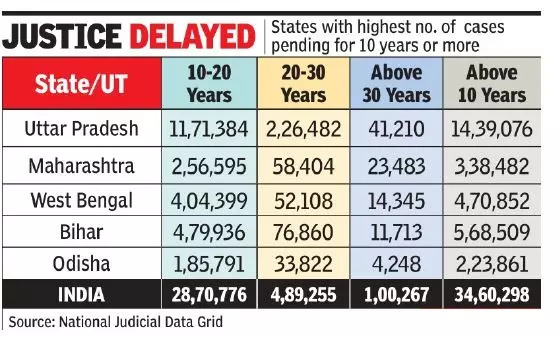Description

Copyright infringement not intended
In News
- According to data compiled from the National Judicial Data Grid, more than one lakh cases are pending in district and taluka courts for 30 years.
- Over 90% of these cases are pending in just 4 states: Uttar Pradesh, Maharashtra, West Bengal, and Bihar.
- Uttar Pradesh leads the list with more than 41,000 cases and is followed by Maharashtra with nearly 23,500 cases.
- Nearly 91,000 cases in just 4 states. They all are large states, but they only have about 42% of India’s population.
- Among large states, Haryana has the lowest number with only 14 such cases.
- There are no pending cases over 30 years in Chandigarh, Daman and Diu, Dadra and Nagar Haveli, Ladakh, Mizoram, Nagaland and Sikkim.
- There are nearly 5 lakh pending cases for 20 to 30 years and 28.7 lakh that are pending cases for 10-20 years.
Details
- Over 31 million cases are pending in Subordinate Courts across the country.
- The high pendency of Cases in Some tribunals indicates that the objective of setting them is not achieved.
- The government, including PSUs and other autonomous bodies, are party to around “46%” of 3.14 crore court cases pending in various courts in the country, making it the biggest litigant in the country.

Concern
- Case pendency Hurts investors’ confidence.
- Economic activity is getting affected by high pendency and delays across the legal system.
- It adds a burden on Courts and collaterally harms other litigants.
- It increases project costs and delays projects.
- Slows down administrative processes, delaying decision-making.
- Diversion of precious resources.
- Effects ease of doing business.
Steps to reduce Pendency by Government
- Adoption of “National Litigation Policy 2010” to transform government into an Efficient and Responsible litigant.
- All states formulated state litigation policies after National Litigation Policy 2010.
- Legal Information Management and Briefing System (LIMBS), was created in 2015 with the objective of tracking cases to which the government is a party.
- The Supreme Court advised the centre that criminals sentenced to imprisonment for 6 months or a year should be allocated social service duties rather than be sent to further choke the already overflowing prisons.
Steps need to be taken
- National Litigation Policy should be revised.
- Address all 3 stages of dispute:
- Pre-litigation
- Litigation
- Post litigation stage.
- Establish Fair accountability mechanisms, Consequences for violation must be provided.
- Appointment of a Nodal Officer to regularly monitor the status of the cases in every department.
- Promotion of alternative dispute resolution mechanisms to encourage mediation.
- Coordinated action between government and judiciary.
- Judicial capacity should be strengthened in the lower courts to reduce the burden on higher courts.
- Increase expenditure on the judiciary.
- Improve court case management and court automation system.
- Create subject-specific benches.
- Tax departments must limit their appeals as their success rate is less than 30% at all three levels of the judiciary.
- Robust internal dispute resolution mechanisms
- Step-by-step online dispute resolution must be adopted as done by the Ministry of Consumer Affairs.
- Judges should write Shorter and more Pointed judgments.
Way Forward
- Courts need to monitor the progress of Cases based on urgency and type of Case.
- Courts must set a time limit to dispose of certain types of Cases.
- Understand why Some Courts perform well despite a Shortage of judges and adopt Such Courts as role models.
- Analytics tools Can be developed in a manner that helps the judges monitor Cases based on parameters Such as how long an accused has been in judicial custody, Cases that Can affect the General public, and Cases that have been long pending.
- Alternative methods should be used for dealing with non-criminal offenders and petty criminals.
https://t.me/+hJqMV1O0se03Njk9











